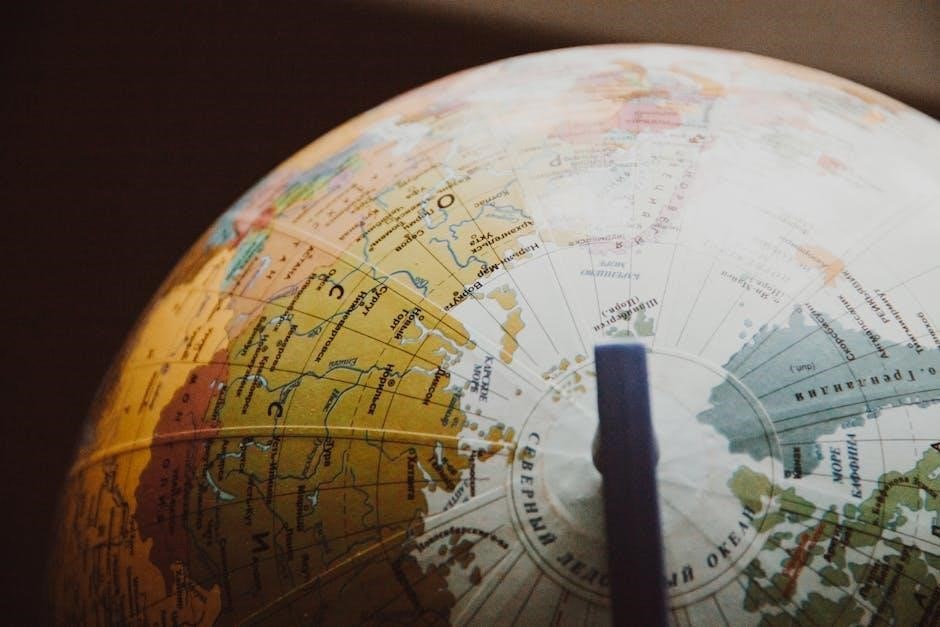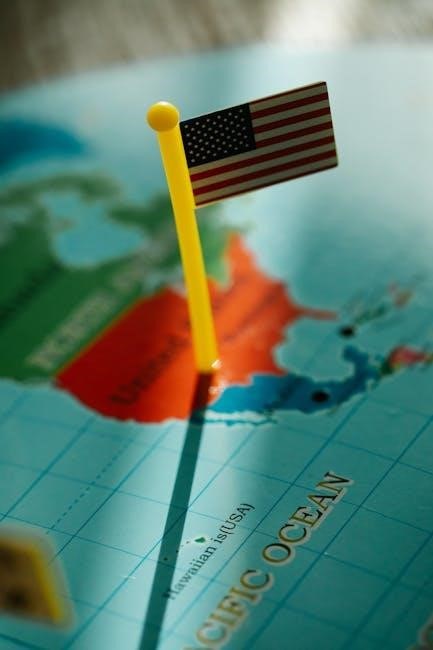Causes of World War I
World War I resulted from a combination of militarism, alliances, imperialism, nationalism, and the assassination of Archduke Franz Ferdinand, creating a volatile environment that led to conflict․
1․1․ Militarism
Militarism, the buildup of military forces and glorification of war, heightened tensions in Europe․ Nations like Germany, France, and Britain engaged in arms races, expanding their armies and navies․ This created an atmosphere of competition and aggression, making war seem inevitable․ Military conscription and the development of advanced weaponry further escalated the situation, contributing to the outbreak of World War I․
1․2․ Alliances
The complex system of alliances in Europe played a crucial role in the outbreak of World War I․ The Triple Entente (France, Britain, Russia) and the Triple Alliance (Germany, Austria-Hungary, Italy) created a volatile environment․ These alliances were both defensive and offensive in nature, fostering loyalty among nations but also limiting diplomatic flexibility․ When tensions rose, the interconnected agreements escalated conflicts, transforming a regional dispute into a global war by drawing more nations into the fight․
1․3․ Imperialism
Imperialism was a significant factor leading to World War I․ European powers competed for colonies and resources, fostering economic and political tensions․ Rivalries over territories in Africa and Asia fueled nationalism and militarism․ The pursuit of empire destabilized global relations, as nations sought to expand their influence, often at the expense of others․ This competition for dominance contributed to the volatile atmosphere that eventually erupted into conflict, making imperialism a root cause of the war․
1․4․ Nationalism
Nationalism played a crucial role in the outbreak of World War I․ It fueled intense loyalty and pride among nations, often leading to the glorification of one’s country over others․ This heightened sense of national identity created tensions, as countries prioritized their own interests above international cooperation․ Nationalist ideologies encouraged aggressive foreign policies and the pursuit of territorial expansion, further destabilizing Europe․ The emphasis on national superiority contributed to the volatile atmosphere, making conflict more likely as nations sought to assert dominance․
Events Leading to World War I
The assassination of Archduke Franz Ferdinand in 1914 triggered a chain reaction of events, activating alliances and leading to the declaration of war between European nations․
2․1․ Assassination of Archduke Franz Ferdinand
On June 28, 1914, Archduke Franz Ferdinand, heir to the Austro-Hungarian throne, was assassinated in Sarajevo by Gavrilo Princip, a Serbian nationalist․ This event triggered a chain reaction of diplomatic crises and military mobilizations․ Austria-Hungary, with German support, issued an ultimatum to Serbia, leading to the declaration of war․ The assassination is widely regarded as the immediate cause of World War I, setting off a global conflict․
2․2․ The System of Alliances and the Declaration of War
The complex system of alliances, including the Triple Entente and Triple Alliance, played a pivotal role in escalating the conflict․ Austria-Hungary’s declaration of war on Serbia triggered a domino effect, as Russia mobilized in support of Serbia, followed by Germany declaring war on Russia and France․ Britain entered the war after Germany invaded Belgium, demonstrating how alliances transformed a regional dispute into a global conflict, with each nation bound by its commitments․

Key Events of World War I
Major battles, trench warfare, and the introduction of new military technologies defined the conflict, while events like the U․S․ entry and the Armistice marked its progression and end․
3․1․ Major Battles and Fronts
The Western Front saw brutal trench warfare, with battles like the Somme, Verdun, and Passchendaele, characterized by massive casualties and stalemate․ The Eastern Front involved Russia, with key battles such as Tannenberg and Brusilov, leading to Russia’s eventual withdrawal․ The Italian Front featured the Battle of Caporetto, while the Middle Eastern Front included conflicts against the Ottoman Empire․ Naval battles, like Jutland, and the introduction of new technologies marked the war’s military evolution and widespread devastation․
3․2․ United States Entry into the War
The United States initially maintained neutrality in World War I, focusing on economic gains through trade․ However, Germany’s resumption of unrestricted submarine warfare and the sinking of the Lusitania outraged the public․ The decisive factor was the Zimmermann Telegram, where Germany attempted to ally with Mexico against the U․S․ These events shifted public opinion, leading Congress to declare war on Germany in April 1917, marking America’s entry into the global conflict․
3․3․ The Armistice and End of the War
World War I ended on November 11, 1918, with the signing of the Armistice of Compiègne․ Germany, facing military collapse and economic strain, agreed to cease hostilities․ The armistice marked a temporary peace, leading to the Paris Peace Conference in 1919․ The war’s conclusion resulted in immense human loss, with over 37 million casualties, and set the stage for the Treaty of Versailles, which imposed harsh penalties on Germany and reshaped the global political landscape․
Treaty of Versailles
The Treaty of Versailles, signed on June 28, 1919, officially ended World War I․ It imposed harsh penalties on Germany, including heavy reparations, territorial losses, and military restrictions․ The treaty also established the League of Nations to promote international cooperation and prevent future conflicts․ Its provisions sowed seeds of resentment in Germany, contributing to tensions leading to World War II․
4․1․ Main Provisions of the Treaty
The Treaty of Versailles included the War Guilt Clause, blaming Germany for the war, and imposed heavy reparations․ Germany lost significant territory and colonies․ Its military was drastically reduced, with limits on troops, ships, and airforces․ The treaty also established the League of Nations to promote peace․ Additionally, it enforced strict territorial adjustments, redrawing national borders and creating new states․ These provisions aimed to punish Germany and prevent future conflicts but fostered widespread resentment and economic hardship․
4․2․ Impact of the Treaty on Germany and Europe
The Treaty of Versailles severely impacted Germany, causing economic hardship through heavy reparations and hyperinflation․ National resentment grew, fueling the rise of extremist groups like the Nazis․ Across Europe, borders were redrawn, creating unstable states and minority tensions․ The collapse of empires like Austria-Hungary and the Russian Empire led to political upheaval․ The treaty’s punitive measures fostered a sense of injustice in Germany, contributing to the rise of Adolf Hitler and the conditions that would lead to World War II․
Home Front During World War I
Nations mobilized economies for war production, while propaganda maintained public support․ Women entered the workforce in unprecedented numbers, playing vital roles in sustaining the war effort․
5․1․ Economic Mobilization and War Production
During World War I, nations shifted their economies to support the war effort, prioritizing weapons and supplies․ Governments took control of industries, increasing production while managing resources․ This economic mobilization led to innovation and efficiency but also caused inflation and labor shortages․ The war effort relied heavily on industrial output, with factories producing ammunition, tanks, and aircraft․ This period marked a significant shift in the role of governments in economic planning and highlighted the importance of industrial capacity in sustaining military campaigns during prolonged conflicts․
5․2․ Propaganda and Public Support for the War
During World War I, governments utilized propaganda to maintain public support and shape opinions․ Posters, films, and media were used to glorify the war effort, promote patriotism, and demonize the enemy․ Propaganda aimed to boost recruitment, justify sacrifices, and suppress dissent․ It played a crucial role in maintaining morale and national unity, ensuring continued support for the war despite its prolonged duration and heavy casualties․
5․3․ Role of Women in the War Effort
During World War I, women assumed unprecedented roles in the workforce, stepping into industries like munitions, textiles, and nursing․ They also participated in volunteer efforts, supporting soldiers and communities․ This shift challenged traditional gender norms and highlighted women’s capabilities․ The war accelerated the movement for women’s suffrage, as their contributions demonstrated their importance to society․ Women’s involvement in the war effort laid the foundation for future gender equality advancements․

Technology and Warfare Innovations
World War I introduced groundbreaking technologies like tanks, aerial combat, and submarines, revolutionizing warfare․ These innovations transformed military strategies and increased the war’s destructiveness and efficiency․
6․1․ Trench Warfare and Its Characteristics
Trench warfare dominated World War I, characterized by stagnant battle lines and massive fortifications․ Soldiers endured horrific conditions, including mud, disease, and constant artillery fire․ Trenches provided limited protection, leading to prolonged stalemates and heavy casualties․ This method of warfare emphasized defense over offense, forcing armies to adapt with new strategies and technologies to break the deadlock․ The trenches became a symbol of the war’s brutal and immobilizing nature, reshaping military tactics forever․
6․2․ Advancements in Military Technology
World War I saw significant advancements in military technology, transforming warfare․ Tanks were introduced to break trench stalemates, while airplanes evolved from reconnaissance tools to combat weapons․ Submarines became key in naval warfare, enabling blockades and attacks on supply lines․ Additionally, chemical warfare emerged, with gases causing widespread casualties․ These innovations increased warfare’s lethality and reshaped military strategies, marking a turning point in modern conflict tactics and equipment development․
Political Consequences of World War I
The war led to the collapse of empires, the rise of new nations, and the Treaty of Versailles, which imposed harsh penalties on Germany, fueling resentment․
7․1․ Fall of Empires and Rise of New Nations
World War I led to the collapse of major empires, including the Russian, German, Austro-Hungarian, and Ottoman Empires․ This resulted in the emergence of new nations such as Poland, Czechoslovakia, and Yugoslavia․ The war’s aftermath also saw the redrawing of national borders, often based on ethnic lines, and the promotion of self-determination as outlined in Woodrow Wilson’s Fourteen Points․ These changes reshaped the political landscape of Europe and the Middle East, creating both opportunities and challenges for the newly independent states․
7․2․ Establishment of the League of Nations
The League of Nations was created after World War I as part of the Treaty of Versailles, with the aim of promoting international peace and preventing future conflicts․ Founded in 1920, it was the first global international organization, with its headquarters in Geneva․ The League’s primary goals were to encourage diplomacy, arbitration, and collective security among nations․ However, it faced significant challenges, including the absence of the United States and its inability to prevent Japanese and Italian aggression in the 1930s, leading to its eventual decline․

Economic and Social Impact
The war caused massive economic losses and a heavy financial burden on nations․ It led to significant social changes, including the rise of revolutionary movements and shifts in societal structures․
8․1․ Cost of the War and Reconstruction
The total cost of World War I was estimated at $33 billion, with nations accumulating massive debts․ Reconstruction efforts faced significant challenges, including inflation, economic instability, and the loss of millions of lives․ The war’s financial burden lingered, affecting global economies and contributing to widespread poverty․ Additionally, the destruction of infrastructure required substantial investment to rebuild, further straining resources and delaying recovery efforts across Europe and beyond;
8․2․ Social Changes and the Rise of Revolutionary Movements
World War I sparked significant social changes and fueled revolutionary movements globally․ The war’s devastation led to widespread disillusionment, fostering radical ideologies like communism and fascism․ The Russian Revolution emerged during the war, resulting in the establishment of the Soviet Union․ Additionally, the war accelerated movements for independence in colonized regions and inspired feminist movements as women took on new roles in society․ These shifts laid the groundwork for future political and social transformations worldwide․

Key Figures of World War I
Woodrow Wilson championed the Fourteen Points for peace, while David Lloyd George and Georges Clemenceau played crucial roles in shaping post-war policies․ Kaiser Wilhelm II and Vittorio Orlando were prominent leaders whose decisions influenced the conflict’s trajectory․
General John Pershing led U․S․ forces, and Marshal Ferdinand Foch coordinated Allied efforts, while Gavrilo Princip ignited the war with his assassination of Archduke Franz Ferdinand․
9․1․ Political Leaders and Their Roles
Woodrow Wilson of the United States championed the Fourteen Points, advocating for self-determination and the League of Nations to prevent future wars․ David Lloyd George led Britain, balancing domestic pressures with wartime strategy, while Georges Clemenceau of France prioritized defeating Germany․ Kaiser Wilhelm II of Germany embodied militarism, and Vittorio Orlando represented Italy’s ambitions․ These leaders shaped the war’s outcome and post-war restructuring, influencing global politics for decades․
9․2․ Military Commanders and Their Strategies
Ferdinand Foch coordinated Allied forces, leading to the Hundred Days Offensive․ Erich Ludendorff masterminded Germany’s Spring Offensive but shifted to defense as losses mounted․ Douglas Haig oversaw British troops, emphasizing heavy artillery and tank deployments․ John Pershing commanded U․S․ forces, focusing on rapid mobilization and decisive action․ Their strategies shaped the war’s outcome, blending innovation with traditional tactics, ultimately influencing the Allied victory and the Central Powers’ defeat․
